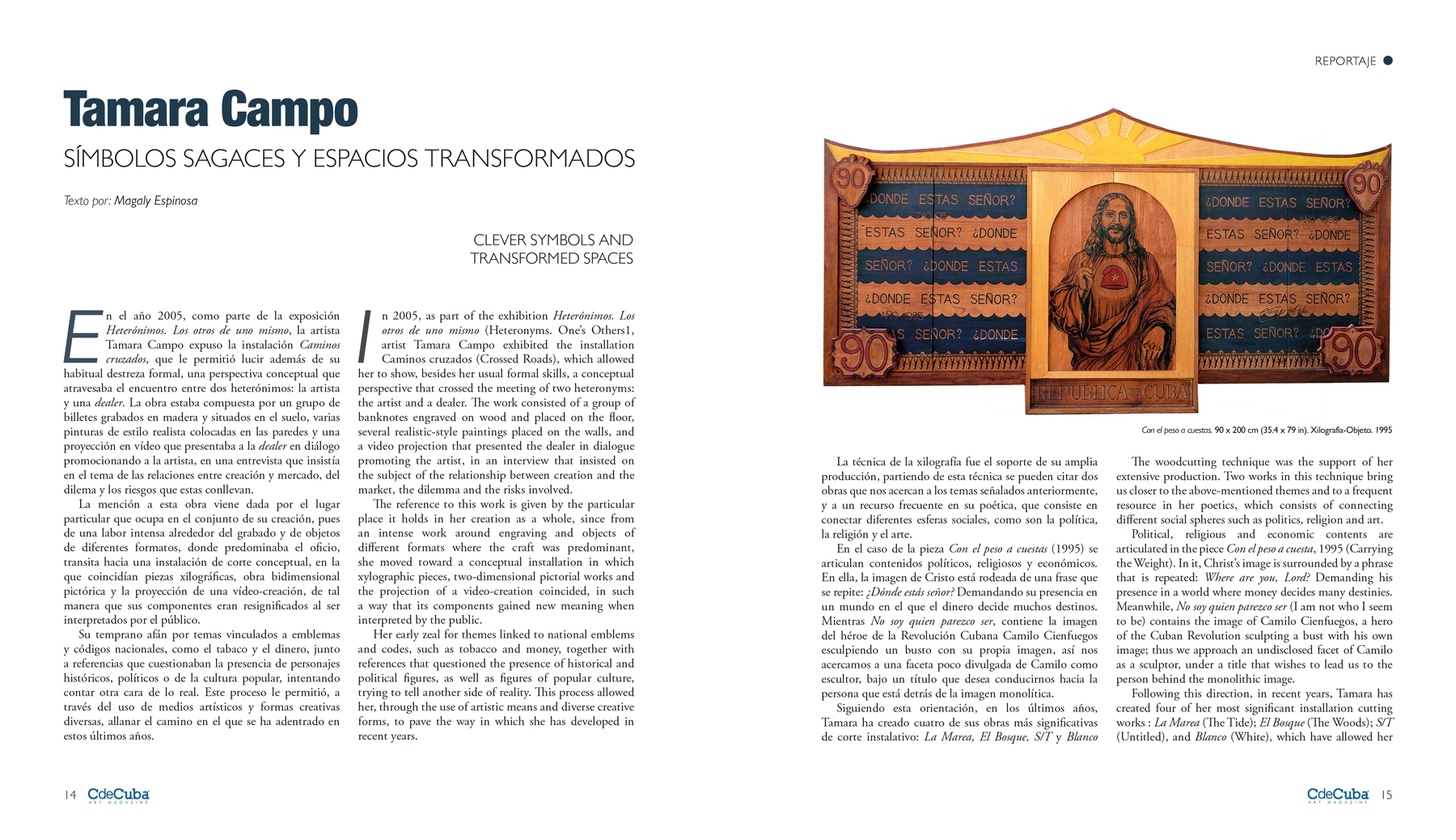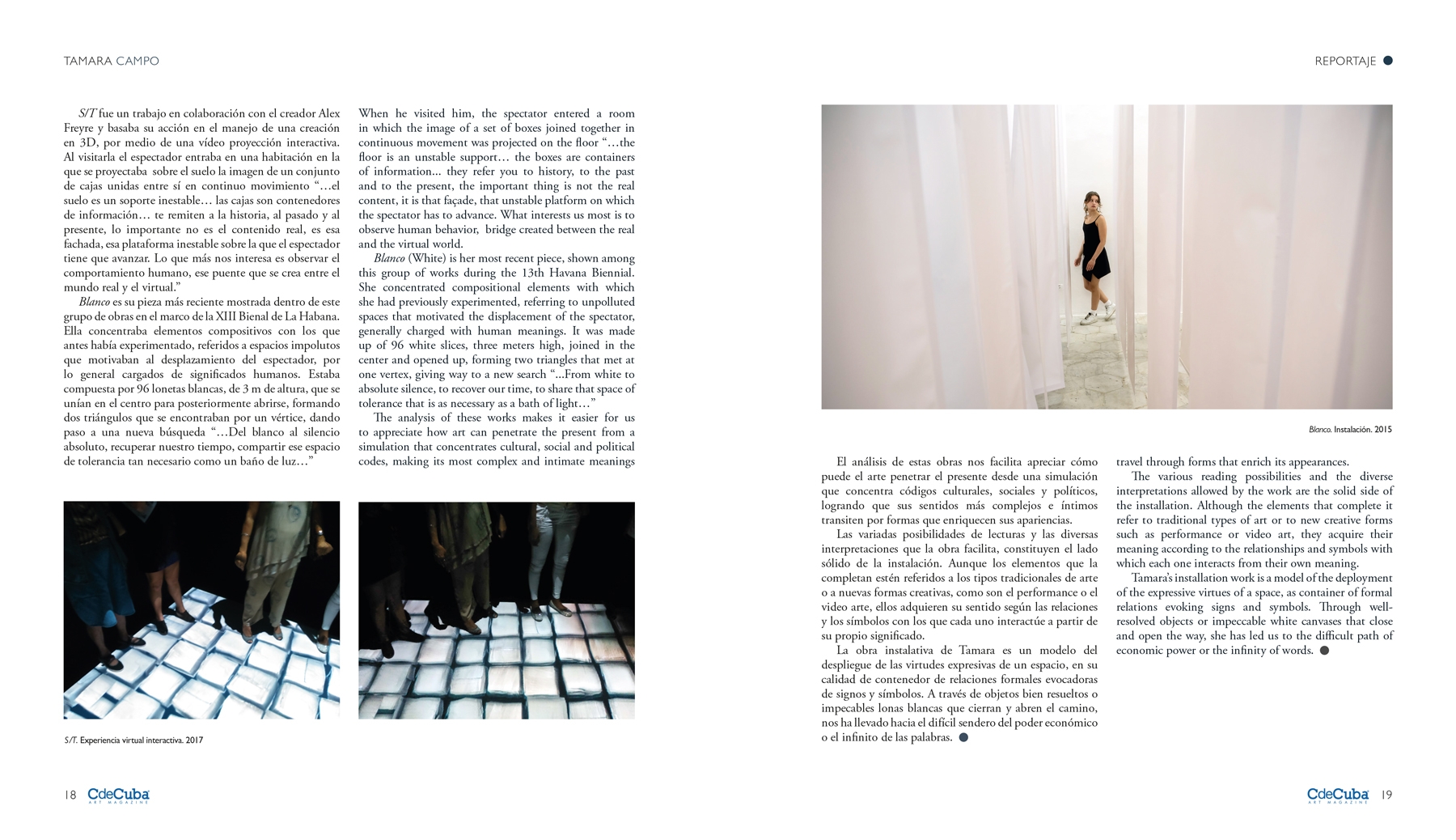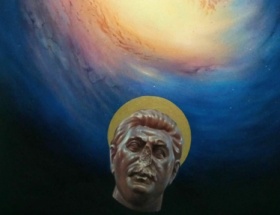Clever Symbols and Transformed Spaces
By Magaly Espinosa
“with them, she takes up again the allegorical enunciation”
Caridad Blanco
In 2005, as part of the exhibition Heterónimos. Los otros de uno mismo (Heteronyms. One’s Others1, artist Tamara Campo exhibited the installation Caminos cruzados (Crossed Roads), which allowed her to show, besides her usual formal skills, a conceptual perspective that crossed the meeting of two heteronyms: the artist and a dealer. The work consisted of a group of banknotes engraved on wood and placed on the floor, several realistic-style paintings placed on the walls, and a video projection that presented the dealer in dialogue promoting the artist, in an interview that insisted on the subject of the relationship between creation and the market, the dilemma and the risks involved.
The reference to this work is given by the particular place it holds in her creation as a whole, since from an intense work around engraving and objects of different formats where the craft was predominant, she moved toward a conceptual installation in which xylographic pieces, two-dimensional pictorial works and the projection of a video-creation coincided, in such a way that its components gained new meaning when interpreted by the public.
Her early zeal for themes linked to national emblems and codes, such as tobacco and money, together with references that questioned the presence of historical and political figures, as well as figures of popular culture, trying to tell another side of reality. This process allowed her, through the use of artistic means and diverse creative forms, to pave the way in which she has developed in recent years.
The woodcutting technique was the support of her extensive production. Two works in this technique bring us closer to the above-mentioned themes and to a frequent resource in her poetics, which consists of connecting different social spheres such as politics, religion and art.
Political, religious and economic contents are articulated in the piece Con el peso a cuesta, 1995 (Carrying the Weight). In it, Christ’s image is surrounded by a phrase that is repeated: Where are you, Lord? demanding his presence in a world where money decides many destinies. Meanwhile, No soy quien parezco ser (I am not who I seem to be) contains the image of Camilo Cienfuegos, a hero of the Cuban Revolution sculpting a bust with his own image; thus we approach an undisclosed facet of Camilo as a sculptor, under a title that wishes to lead us to the person behind the monolithic image.
Coinciding with a transition from engraving objects to sculpture, in 1996 the artist undertook the installation La Nube2 (The Cloud), seeking the experimentation possibilities offered by this medium. In this case, the spectator entered a room where sticks and bushes hanging from the ceiling held the tobacco leaves at his height, very close to each other, in tight sections, like a green cloud that dried up over the days, increasing the smell of this plant.
Following this direction, in recent years, Tamara has created four of her most significant installation cutting works : La marea3 (The Tide); El bosque4 (The Woods);S/T5 (Untitled), and Blanco6 (White),which have allowed her to continue using, at the same time, the engraving and the contents to which she frequently resorts.
The first of these works is made up of 750 banknotes from different countries carved in wood and with woodcut prints, according to the figuration they show of the country to which they belong. They were exhibited “… hanging from the ceiling, hanging from almost imperceptible threads… making them transmit… a sensation of weightlessness that contrasts with the heavy printing of the wood and the weight symbol itself… The memory of the sea moving through the title and the metaphor it represents serves as conceptual background to bring us closer to the instability of the symbol, an allegory that synthesizes the social dynamics of such hesitant and insecure mechanism… The visitor will move between the rise and fall of the bills, as he or she walks through them, entering into the metaphor evoked by the title and knowing that this “hard” social symbol brings at the same time pain and well-being. It is ironic that putting it in motion represents a similarity with the coming and going of the tides, which rise and fall depending on the behavior of the natural conditions that produce them…”
The second installation, El Bosque (The Forest), is linked to spiritual symbols and meanings. Black bands of craft paper, three meters high and 50 cm wide, covered the entire space in alternate rows, so that the viewer had to separate them to find the end and read a text of light with the words: “They correspond to a passage in the Bible referring to what Jesus said when he explained to his disciples his action of restoring sight to a blind man: ‘I must do the works of He who sent me, while the day lasts; the night comes when no one can work.”8
“…The artist synthesizes said phrase, she is interested in achieving a more direct effect. The night evoked by Jesus is a simile that appeals to the moment when the light is gone and everything stops; we can no longer take action, make changes. But this message comes to us after the journey, the attempt to come out of the shadows, to leave so many doors behind.”9
Unlike the previous installation, “…she did not concentrate her skills in the domain of engraving, but adapted her interest to the possibilities offered by the perception of a space, and from there create the atmosphere that turns simple bands into a metaphysical forest, without branches, devoid of all adornment. In this way she uses an artistic medium that activates the senses, involving body and mind through the very act of perception…10
S/T (Untitled) was a collaborative work with creator Alex Freyre and based its action on the handling of a 3D creation by means of an interactive video projection. When he visited him, the spectator entered a room in which the image of a set of boxes joined together in continuous movement was projected on the floor “…the floor is an unstable support… the boxes are containers of information… they refer you to history, to the past and to the present, the important thing is not the real content, it is that façade, that unstable platform on which the spectator has to advance. What interests us most is to observe human behavior, bridge created between the real and the virtual world.
Blanco (White) is her most recent piece, shown among this group of works during the 13th Havana Biennial. She concentrated compositional elements with which she had previously experimented, referring to unpolluted spaces that motivated the displacement of the spectator, generally charged with human meanings. It was made up of 96 white slices, three meters high, joined in the center and opened up, forming two triangles that met at one vertex, giving way to a new search “…From white to absolute silence, to recover our time, to share that space of tolerance that is as necessary as a bath of light…”12
The analysis of these works makes it easier for us to appreciate how art can penetrate the present from a simulation that concentrates cultural, social and political codes, making its most complex and intimate meanings travel through forms that enrich its appearances.
The various reading possibilities and the diverse interpretations allowed by the work are the solid side of the installation. Although the elements that complete it refer to traditional types of art or to new creative forms such as performance or video art, they acquire their meaning according to the relationships and symbols with which each one interacts from their own meaning.
Tamara’s installation work is a model of the deployment of the expressive virtues of a space, as container of formal relations evoking signs and symbols. Through well-resolved objects or impeccable white canvases that close and open the way, she has led us to the difficult path of economic power or the infinity of words.
1. Conde Duque Cultural Center, in Madrid: Caja Madrid Foundation. Espai Cultural. Spain, 2005 and Museo Metropolitano. Quito, Ecuador, 2006.
2. Green tobacco and bushings. Variable dimensions, 1996.
3. The first version of this work was presented at the Museum of Art of Pinar del Rio (MAPRI), 2011; the second one at the fortress of La Cabaña, 11th Havana Biennial. Havana, 2012.
4. It was exhibited at the Arturo Regueiro Gallery. Pinar del Rio, 2014, and at the fortress of La Cabaña, on the occasion of the 12th Havana Biennial. Havana, 2015.
5. 7th Cuban Salon of Contemporary Art. Center for the Development of Visual Arts. Havana. 2017-2018.
6. Wifredo Lam Contemporary Art Center. 13th Havana Biennial. Havana, 2019. Guest artist at the Central Exhibition.
7. Espinosa, Magaly. The Tide. Words for the brochure on the work of the same name. Artist Tamara Campo. 11th Havana Biennial. In: Cuban Art News. No 8/2011. P. 15.
8. “Santa Biblia” (Holy Bible) Ed. United Bible Societies. Revision of 1960. Mexico. 1960. Pp. 986.
9. Espinosa, Magaly. Wide black bands. Words for the brochure on the work: The forest. Artist Tamara Campo. 12th Havana Biennial. 2015.
10. Idem.






